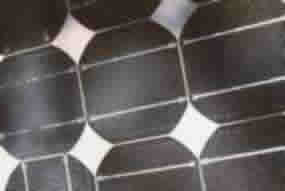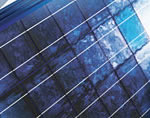| PV: Photo-Voltaic
means electricity from light. Basically, there are three major
types of solar cells: | Single
Crystal: (monocrystalline) Each cell is made of a single crystal of silicone.
Our best modules are made with this type of cell. They are the most efficient,
perform the best in most conditions, and last the longest.They cost more, but
are worth it. The first single crystal solar cells made by Bell labs in the 1950s
still produce electricity! |  |
| Multi Crystal: (polycrystalline) Each cell is made of many crystals.
Our discount modules are made with these. They work well and are cheaper. |  |
| Amorphous: these cells are grown without crystals at all.
They are good for specialty applications like roofing or RVs, because they can
work if shaded, and can bend. They can deteoriate in sunlight and are the least
efficient. |  |
| Type of Cell |
Examples |
Life span:
Warranties |
Efficiency:
Area of 1000 watt
Array |
Performance
Early Morning, Late Afternoon, Cloudy |
Performance,
partially shaded by tree |
Performance,
Hot weather |
|
Single
Crystal |
Solar
World SunModule |
Best,
25 years to 90% |
Best
80 sq ft. |
Excellent |
Poor |
Best
|
|
Muti
Crystal |
BP,
Photowatt, Kyocera |
20
years to 90% |
95
sq ft |
OK |
Poor |
OK |
|
Amorphous |
Unisolar |
least,
20 year to 80% |
Worst
170 sq. ft. |
Good |
OK |
Good |
The Chart Explained: Life
Span: History is our best indicator of lifespan.The first monocrystalline
cells made by Bell Laboratories in the 50s still work! Vice versa, the first amphorous
cells made in the 70s deteriorated rapidly in sunlight, and gave solar a bad name.
All modules deteriorate slightly over the years, and the new amorphous panels
carry 20 year warranties, so you'll worry more about whether the sun will shine.
Warranty accounts for normal degradation. Notice Amorphous have fewer years and
allow double the degradation. Efficiency: is how much of the sun's
energy that is converted to electricity. Our rating shows how many square feet
of space 1000 watts of solar modules take. Notice the mono-crystal panels take
less than half the space of an amorphorous array. That means smalller mounting
racks, thus saving money. Early Morning, etc Performance: this indicates
how much power the module makes when the sun isn't hitting the module straight
on or it is cloudy. While all modules should make their rated power under perfect
conditions, single crystal modules put out more power under more conditions to
be worth their extra cost. Partially Shaded Performance: Normally,
a solar module should be located so that it is never shaded from 9 AM till 3 PM
year round. Just the shadow from a TV antenae or tree branch can keep an entire
monocrytalline module from working. Amorphous have an edge here, and are a good
choice for an RV that may park in shade. However, its usually better to relocate
the module, or remove the obstruction instead. Hot Weather Performance:
Solar modules lose voltage as their temperature goes up. A module can be
close to 100 deg F , when it is only 65 deg F outside . They can get as hot as
160 deg F in the summer in the desert on a roof. However, modules are rated at
77 deg F (25 C), so modules are going to perform their best in colder weather.
Luckily most systems have a surplus of power in the summer, so the power loss
then is tolerable. In extremely cold weather with bright sun and snow reflection,
modules can actually exceed their rated output! Module
Ratings: All modules are rated at Standard Test Conditions (STC). These
are alomst perfect conditions in which full sun is shinning straight on the module,
& the module temperature is 77 deg F. These conditions actually occur in the
winter for a few hours on clear days, but are not a complete picture of the module's
performance year round in a real life situation. Another standard is being used
(PTC) which measures air temperature (usually a module is much hotter than the
surrounding air). Modules are usually derated from 10% to 25% under this rating
system. The following table will explain the different module ratings listed
on the back of each module:
Maximum
Power
P |
The
most watts produced by a module under standard test conditions. In
Real life conditions a module may make only 80 to 90% of this rating,
due to heat, dirt, wire losses, and the fact that the module may be
operating at lower voltage. |
Voltage(max
power)
V |
The voltage at which a module makes its most power. ( For example,
a 12 volt nominal module, Vmp can be as high as 17 volts.) |
Voltage
(open circuit)
Voc |
the
module's highest voltage at no current. (A 12 volt nominal module
may go over 22volts) |
Amps
(max power)
A |
the current at the module's "sweet spot" or Max Power Point.
(usually around 90% of short circuit current) |
Amps
(short circuit)
A |
the highest current the module can make at no voltage. |
| Maximum
series Fuse |
tells
the biggest size fuse or breaker to use with the module. Modules with
a higher rating, can be paralleled in some cases to save on wiring
and breakers. |
Its
easiest to compare modules on a dollars per watt basis.(Divide the module's price
by its power rating) Just because one module is cheaper than another means nothing
without comparing the price per watt. Also monocrytalline is worth 10% more per
watt, because it will make more power throughout the day and throughout the year
than the same wattage module in polycrystalline. Wiring Modules Solar
modules are wired in different combinations to get the voltage & current needed.
They are wired in series to increase voltage; up to 30 modules can be strung together
for voltages as high as 600 v (the highest voltage most modules are rated for).
The voltages of each module are added together. (see
Wiring Diagrams for series and parallel wiring) Modules are also paralleled
to increase current. The voltage stays the same, but their currents are added.
Some 12 volt systems can have dozens of modules in parallel for currents close
to 100 amps. To avoid too much current in a single module that can overheat and
melt connectors, the modules are wired into subarrays. Each subarray carries as
much current as the modules are designed for including a safety factor. This factor
includes both a 25% safety factor and a 25% factor in case the modules produce
more than their rated power in special sunlight conditions (see edge of cloud
effect in glossary). Example: If a module's series fuse rating is 20 amps,
then you divide that by the combined safety factor of 1.56. so you could safely
wire 12.8 amps of modules together in parallel. If each module's short circuit
current is 4.2 amps, then you could parallel 3 modules. Regardless, we don't recommend
ever wiring more than 4 modules in parallel in one subarray, and some inspectors
don't allow any parallel wiring within a subarray.
Link to Catalog for Current Listings.
|